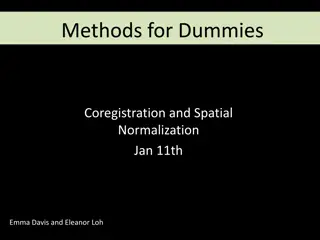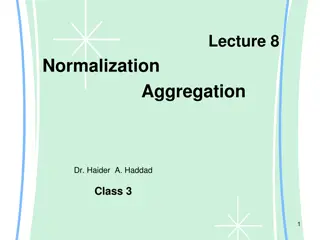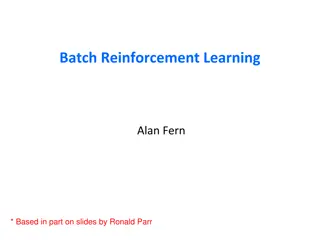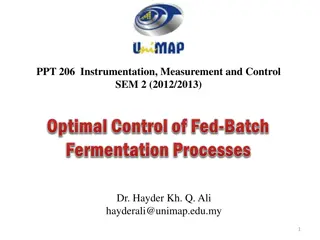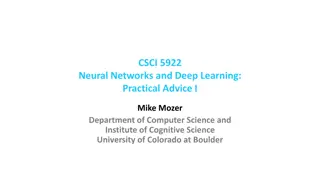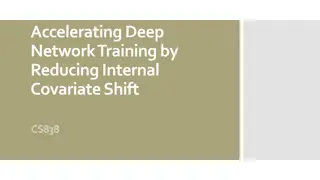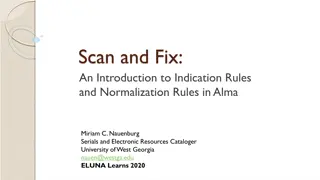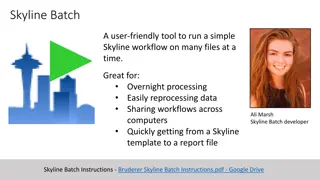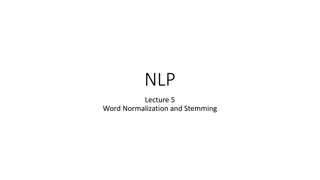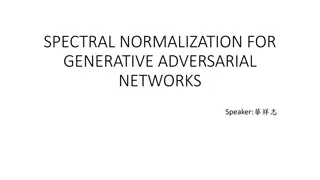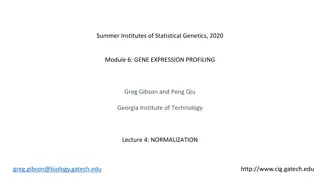
Understanding Batch Normalization in Deep Neural Networks
Batch normalization (BN) is a technique used to normalize activations in deep neural networks, improving accuracy and speeding up training. This method enables training with larger learning rates, leading to faster convergence and better generalization. Despite the success of BN, there is still debate on the exact mechanisms behind its effectiveness.
Download Presentation

Please find below an Image/Link to download the presentation.
The content on the website is provided AS IS for your information and personal use only. It may not be sold, licensed, or shared on other websites without obtaining consent from the author. If you encounter any issues during the download, it is possible that the publisher has removed the file from their server.
You are allowed to download the files provided on this website for personal or commercial use, subject to the condition that they are used lawfully. All files are the property of their respective owners.
The content on the website is provided AS IS for your information and personal use only. It may not be sold, licensed, or shared on other websites without obtaining consent from the author.
E N D
Presentation Transcript
Understanding Batch Normalization Ari Orre 10.10.2019 1
Agenda Related work Intro and the Batch Normalization Algorithm Experimental setup Disentangling the benefits of Batch Normalization Gradients, losses and learning rates Random initialization 10.10.2019 2
Related Work Sergey Ioffe and Christian Szegedy. Batch normalization: Accelerating deep network training, 2015. The original batch normalization paper posits that internal covariate explains the benefits of BN by reducing internal covariate shift. Claim here that internal covariate shift can exist, but that success of BN can be explained without it. Argue that a good reason to doubt that the primary benefit of BN eliminating internal covariate shift comes from results from Mishkin and Matas, where an initialization scheme ensures that all layers are normalized In this setting, internal covariate shift would not disappear, and the authors show that such initialization can be used instead of BN with a relatively small performance loss Another relevance is Smith & Topin and Smith, where the relationship between various network parameters, accuracy and convergence speed is investigated the former article argues for the importance of batch normalization to facilitate a phenomenon dubbed super convergence The report proposes several efficient ways to set the hyper-parameters that significantly reduce training time and improves performance Dmytro Mishkin and Jiri Matas. All you need is a good init, 2015. Leslie N Smith and Nicholay Topin. Super- convergence: Very fast training of residual networks using large learning rates , 2017. Leslie N Smith. A disciplined approach to neural network hyper-parameters: Part 1 learning rate, batch size, momentum, and weight decay, 2018. 10.10.2019 3
Introduction Batch normalization (BN) is a technique to normalize activations in intermediate layers of deep neural networks. Has tendency to improve accuracy and speedup training little consensus on the exact reason and mechanism behind these improvements Several experiments show that BN primarily enables training with larger learning rates, which is the cause for faster convergence and better generalization Networks without BN we demonstrate how large gradient updates can result in diverging loss and activations growing uncontrollably with network depth, which limits possible learning rates. BN avoids this problem by constantly correcting activations to be zero-mean and of unit standard deviation, which enables larger gradient steps, yields faster convergence and may help bypass sharp local minima. 10.10.2019 4
Introduction Nowadays, there is little disagreement in the machine learning community that BN accelerates training, enables higher learning rates, and improves generalization accuracy and BN has successfully proliferated throughout all areas of deep learning despite its undeniable success, there is still little consensus on why the benefits of BN are so pronounced In addition to internal covariate shift the tendency of the distribution of activations to drift during training, other explanations such as improved stability of concurrent updates or conditioning have also been proposed. 10.10.2019 5
Introduction A small subset of activations in deep layer may explode . The typical practice to avoid such divergence is to set the learning rate to be sufficiently small Small learning rates yield little progress along flat directions of the optimization landscape May be more prone to convergence to sharp local minima with possibly worse generalization performance BN avoids activation explosion by repeatedly correcting all activations to be zero-mean and of unit standard deviation With this safety precaution , it is possible to train networks with large learning rates Activations cannot grow incontrollably since their means and variances are normalized. SGD with large learning rates yields faster convergence along the flat directions of the optimization landscape and is less likely to get stuck in sharp minima. Investigation of interval of viable learning rates for networks with and without BN Conclude that BN is much more forgiving to very large learning rates Experimentally demonstrate that the activations in deep networks without BN grow dramatically with depth if the learning rate is too large. 10.10.2019 6
The Batch Normalization Algorithm Primarily consider BN for convolutional neural networks BN subtracts the mean activation from all input activations in channel c, where B contains all activations in channel c across all features b in the entire mini-batch and all spatial x, y locations. BN divides the centered activation by the standard deviation plus for numerical stability BN applies the same normalization for all activations in a given channel, During testing, running averages of the mean and variances are used. 10.10.2019 7
Experimental Setup Image classification on CIFAR10 with a 110 layer Resnet We use SGD with momentum and weight decay, employ standard data augmentation and image preprocessing techniques and decrease learning rate when learning plateaus The original network can be trained with initial learning rate 0.1 over 165 epochs, however which fails without BN. Here reported the best results among initial learning rates from {0.1, 0.003, 0.001, 0.0003, 0.0001, 0.00003} and use enough epochs such that learning plateaus. 10.10.2019 8
Disentangling the benefits of BN Without batch normalization found that the initial learning rate of the Resnet model needs to be decreased to = 0.0001 for convergence and training takes roughly 2400 epochs. The unnormalized network. Train a batch normalized network using the learning rate and the number of epochs of an unnormalized network + an initial learning rate of = 0.003 which requires 1320 epochs for training. This configuration does not attain the accuracy of its normalized counterpart. The figure shows that with matching learning rates, both networks, with BN and without, result in comparable testing accuracies (red and green lines in right plot) In contrast, larger learning rates yield higher test accuracy for BN networks, and diverge for unnormalized networks. results are averaged over five runs with std shown as shaded region around mean. The batch normalized networks with such a low learning performs no better than an unnormalized network Benefits: improves regularization, accuracy and gives faster convergence. The training and testing accuracies 10.10.2019 9
Learning rate and generalization In simple model of SGD the loss function (x) is a sum over the losses of individual examples in our dataset We model SGD as sampling a set B of examples from the dataset with replacements and then with learning rate estimate the gradient step as Depending on the tightness of this bound, it suggests that the noise in an SGD step is affected similarly by the learning rate as by the inverse mini-batch size |B1|. This has indeed been observed in practice in the context of parallelizing neural networks It is widely believed that the noise in SGD has an important role in regularizing neural networks Large mini-batches lead to convergence in sharp minima, which often generalize poorly. The intuition is that larger SGD noise from smaller mini-batches prevents the network from getting trapped in sharp minima and therefore bias it towards wider minima with better generalization upper-bound the noise of the gradient step estimate suggests that the noise in an SGD step is affected similarly by the learning rate as by the inverse mini-batch size Argue that the better generalization accuracy of networks with BN can be explained by the higher learning rates that BN enables. 10.10.2019 10
Batch normalization and divergence Diverge for large rates, which typically happens in the first few mini-batches. We therefore focus on the gradients at initialization. Comparing the gradients between batch normalized and unnormalized networks one consistently finds that the gradients of comparable parameters are larger and distributed with heavier tails in unnormalized networks. Histograms over the gradients at initialization for (midpoint) layer 55 of a network with BN and Without. 10.10.2019 11
Loss landscape along the gradient direction For each network compute the gradient on individual batches and plot the relative change in loss as a function of the step-size (i.e. new_loss/old_loss) Different scales along the vertical axes For unnormalized networks only small gradient steps lead to reductions in loss networks with BN can use a far broader range of learning rates. define network divergence as the point when the loss of a mini-batch increases beyond 10^3 a point from which networks have never managed to recover to acceptable accuracies 1212 10.10.2019
Means and variances of the network activations along a diverging update Figure shows the means and variances of channels in three layers during an update without BN The color bar reveals that the scale of the later layer s activations and variances is orders of magnitudes higher than the earlier layer. This suggest that the divergence is caused by activations growing progressively larger with network depth, the network output exploding which results in a diverging loss. BN successfully mitigates this phenomenon by correcting the activations of each channel and each layer to zero-mean and unit standard deviation, which ensures that large activations in lower levels cannot propagate uncontrollably upwards. Argue that this is the primary mechanism by which batch normalization enables higher learning rates. Consistent also with the general folklore observations that shallower networks allow for larger learning rates In shallower networks there aren t as many layers in which the activation explosion can propagate. Needs to updated for every batch for security guarantee to hold. -> updating every other batch does not enable higher learning rates Moments of unnormalized networks explode during network divergence The vertical axis denote what percentage of the gradient update has been applied, 100% corresponds to the endpoint of the update. 13 10.10.2019 13
Batch normalization and gradients Moments as a function of the layer depth after initialization (without BN) in log-scale. The means and variances of channels in the network tend to increase with the depth of the network even at initialization time suggesting that a substantial part of this growth is data independent. Note that the network transforms normalized inputs into an output that reaches scales of up to 102 for the largest output channels It is natural to suspect that such a dramatic relationship between output and input are responsible for the large gradients To test this intuition, train a Resnet that uses one batch normalization layer only at the very last layer of the network, normalizing the output of the last residual block but no intermediate activation. Such an architecture allows for learning rates up to 0.03 and yields a final test accuracy of 90.1% capturing two-thirds of the overall BN improvement Average channel means and variances as a function of network depth at initialization (error bars show standard deviations). The batch normalized network the mean and variances stays relatively constant throughout the network. For an unnormalized network, they seem to grow almost exponentially with depth. This suggests that normalizing the final layer of a deep network may be one of the most important contributions of BN. For the final output layer corresponding to the classification, a large channel mean implies that the network is biased towards the corresponding class. 10.10.2019 14
Batch normalization and gradients A yellow entry indicates that the gradient is positive, and the step along the negative gradient would decrease the prediction strength of this class for this particular image. A dark blue entry indicates a negative gradient, indicating that this particular class prediction should be strengthened. Each row contains one dark blue entry, which corresponds to the true class of this particular image (as initially all predictions are arbitrary). A striking observation is the distinctly yellow column in the left heatmap (network without BN). This indicates that after initialization the network tends to almost always predict the same (typically wrong) class, which is then corrected with a strong gradient update In contrast, the network with BN does not exhibit the same behavior, instead positive gradients are distributed throughout all classes. A heat map of the output gradients in the final classification layer after initialization. The columns correspond to a classes and the rows to images in the mini-batch. For an unnormalized network (left), it is evident that the network consistently predicts one specific class (very right column), irrespective of the input. As a result, the gradients are highly correlated. For a batch normalized network, the dependence upon the input is much larger. Figure heds light onto why the gradients of networks without BN tend to be so large in the final layers: the rows of the heatmap (corresponding to different images in the mini- batch) are highly correlated Especially the gradients in the last column are positive for almost all images (the only exceptions being those image that truly belong to this particular class label). The gradients, summed across all images in the minibatch, therefore consist of a sum of terms with matching signs and yield large absolute values. these gradients differ little across inputs, suggesting that most of the optimization work is done to rectify a bad initial state rather than learning from the data. 10.10.2019 15
Gradients of a convolutional kernel as described in at initialization. The table compares the absolute value of the sum of gradients, and the sum of absolute values. Without BN these two terms are similar in magnitude, suggesting that the summands have matching signs throughout and are largely data independent. For a batch normalized network, those two differ by about two orders of magnitude. Gradients of convolutional parameters We observe that the gradients in the last layer can be dominated by some arbitrary bias towards a particular class. Can a similar reason explain why the gradients for convolutional weights are larger for unnormalized networks. For an unnormalized networks the absolute value of (4) and the sum of the absolute values of the summands generally agree to within a factor 2 or less. For a batch normalized network, these expressions differ by a factor of 10^2, which explains the stark difference in gradient magnitude between normalized and unnormalized networks observed in Figure 2. These results suggest that for an unnormalized network, the summands in are similar across both spatial dimensions and examples within a batch. They encode information that is neither input-dependent or dependent upon spatial dimensions, and argue that the learning rate would be limited by the large input- independent gradient component and that it might be too small for the input-dependent component. 10.10.2019 16
Gradients of convolutional parameters Table suggests that for an unnormalized network the gradients are similar across spatial dimensions and images within a batch. It s unclear however how they vary across the input/output channels i, o. To study this we consider the matrix M at initialization, which intuitively measures the average gradient magnitude of kernel parameters between input channel i and output channel o The heatmap shows a clear trend that some channels constantly are associated with larger gradients while others have extremely small gradients by comparison. Since some channels have large means, we expect that weights outgoing from such channels would have large gradients which would explain the structure Average absolute gradients for parameters between in and out channels for layer 45 at initialization. For an unnormalized network, we observe a dominant low-rank structure. Some in/out-channels have consistently large gradients while others have consistently small gradients. This structure is less pronounced with batch normalization (right). 10.10.2019 17
Random initialization Argue that the gradient explosion in networks without BN is a natural consequence of random initialization. The idea seems to be at odds with the trusted Xavier initialization scheme which is used. Doesn t such initialization guarantee a network where information flows smoothly between layers? These initialization schemes are generally derived from the desiderata that the variance of channels should be constant when randomization is taken over random weights. We argue that this condition is too weak. Let us consider a simple toy model: a linear feed-forward neural network where At ... A2A1x = y, for weight matrices A1, A2...An Now, if the matrices are initialized randomly, the network can simply be described by a product of random matrices. Such products have recently garnered attention in the field of random matrix theory, from which we have the following recent result due to A closer look at reveals that the distribution blows up as x M/(M+1) nears the origin, and that the largest singular value scales as O(M) for large matrices. By multiplying more matrices, which represents a deeper linear network, the singular values distribution becomes significantly more heavy-tailed. Intuitively this means that the ratio between the largest and smallest singular value (the condition number) will increase with depth 10.10.2019 18
Random initialization Gradient descent can be characterized by the condition number of A, the ratio between largest max and smallest singular value min. Increasing has the following effects on solving a linear system with gradient descent: 1) convergence becomes slower 2) a smaller learning rate is needed 3) the ratio between gradients in different subspaces increases There are many parallels between these results from numerical optimization, and what is observed in practice in deep learning. For an unnormalized Resnet one can use a much larger learning if it has only few layers, An increased condition number also results in different subspaces of the linear regression problem being scaled differently, although the notion of subspaces are lacking in ANNs Suggests that such an initialization will yield ill-conditioned matrices, independent of these scale factors. If we accept these shortcomings of Xavier-initialization, the importance of making networks robust to initialization schemes becomes more natural. 10.10.2019 19
Conclusions Investigated batch normalization and its benefits latter are mainly mediated by larger learning rates Argue that the larger learning rate increases the implicit regularization of SGD, which improves generalization Experiments show that large parameter updates to unnormalized networks can result in activations whose magnitudes grow dramatically with depth Limits large learning rates We have demonstrated that unnormalized networks have large and ill-behaved outputs, results in gradients that are input independent From recent results in random matrix theory it is argued that the ill-conditioned activations are natural consequences of the random initialization suggest that traditional initialization schemes may not be well suited for networks with many layers unless BN is used to increase the network s robustness against ill-conditioned weights. 10.10.2019 20
Questions Methods to train very deep neural network like the paper Dynamical isometry and a mean field theory of cnns: How to train 10,000-layer vanilla convolutional neural networks. 10.10.2019 21

